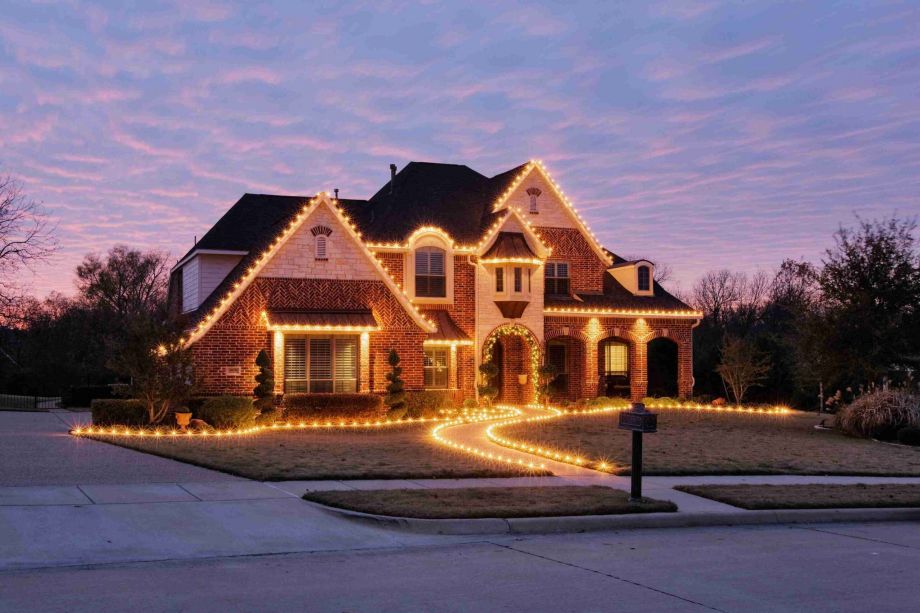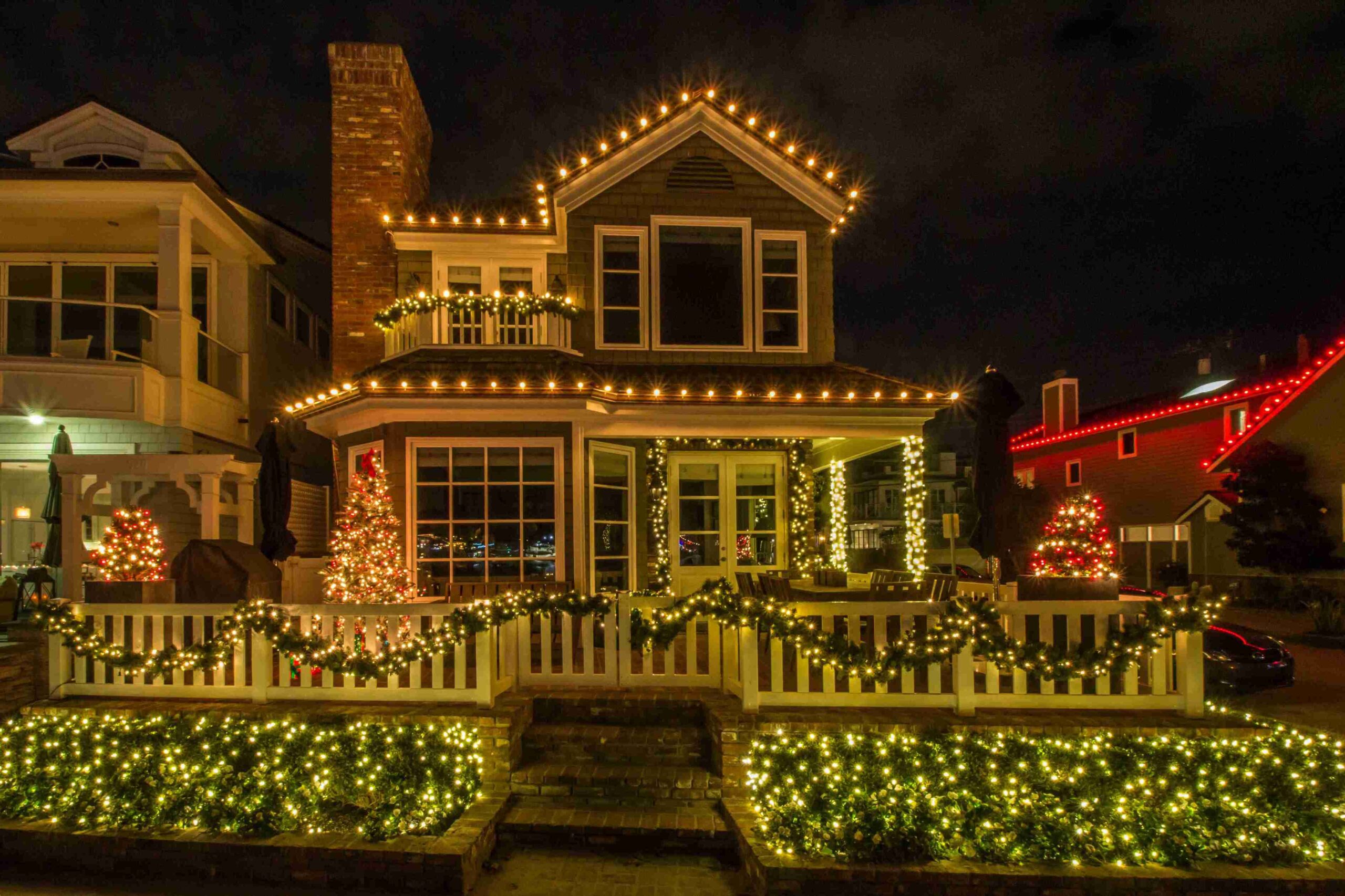
How Much Do Trim Lights Cost In Virginia?
Thinking about lighting up your house with permanent trim lights?
You’re not alone. More and more homeowners in Virginia are ditching the ladders and tangled holiday lights for a clean, year-round setup that looks amazing in every season.
These lights are sleek, smart, and built to last. Plus, they take your curb appeal up a notch – without any extra work once they’re up.
But let’s get real: one of the first things you probably want to know is how much this all costs.
In this post we’ll shed some light on how much trim lights cost, and the factors that affect your final bill. We’ll also break down our permanent trim lighting prices.
How Much Does Trim Lights Cost?
Trim light installations cost somewhere between $20 and $35 per linear foot in Virginia.
So, for a house with about 150 feet of roofline, you’re looking at a ballpark of $3,000 to $5,250.
If your house has more corners, levels, or extra trim, that number can climb. Bigger homes with around 250 to 400 feet of roofline might land in the $6,000 to $12,000 range.
DIY kits are an option too. You can save money upfront, but it means handling everything yourself like ladder work, wiring, mounting, and making it all look clean. Materials alone for DIY usually cost around $12 to $18 per foot, depending on the quality you go for.
So in short:
- Pro install (with materials and labor): $20 – $35 per foot
- DIY (materials only): $12 – $18 per foot
- Small homes: $3,000 to $5,000
- Larger homes: $6,000+ and up
Let’s get into what makes that number go up or down in a sec.

Also Read: How Much Does Christmas Light Installation Cost?
Our Permanent Trim Light Prices
At Dominion Lightworks, we offer two main types of permanent trim lighting:
- Outward-facing
- Under-soffit lighting
Both look great, and both fall in about the same price range. Most of the time, you can expect to pay between $25 and $35 per linear foot, depending on how complex the install is.
Things like the number of cuts, angles, roof breaks, and dormers can affect the total. So, homes with simpler rooflines tend to be on the lower end of that range.
Most residential jobs can expect to spend $2,500 – $4,500 on the front fascia.
Factors That Affect The Cost Of Trim Lights
There are quite a few things that play into the final price. Some are obvious like how big your house is while others might surprise you.
Here’s what really matters when figuring out how much you’ll pay:
#1 Total Linear Feet
This one’s pretty obvious, but it’s worth mentioning.
The more roofline you want covered, the more you’re going to pay.
Most contractors measure the perimeter of your roofline where you want the lights installed. If your roofline is straightforward with just a few peaks and turns, that keeps things cheaper.
But if it wraps around, has a bunch of angles, or includes back patios or garages, it adds up fast.
And while more feet = more money, some installers offer discounts for bigger jobs. So your per-foot cost might actually go down a little with larger installs.
Also Read: Is Uplighting Worth It?
#2 Home Complexity
Got a simple ranch house with clean rooflines? Lucky you.
Your installation is going to be way cheaper than your neighbor with the Victorian-style home that has more peaks and valleys than the Blue Ridge Mountains.
Complex rooflines mean more cuts, more connections, and more time for installation. Every corner, peak, and architectural detail adds to the labor cost. Multi-story homes require ladders, scaffolding, or even lifts in some cases.
So if your house has a lot of dormers, bay windows, or intricate trim work, expect to pay more.
It’s not just about the difficulty. It’s about the time it takes to do the job right.
#3 Type Of Trim Light System
There’s a wide range of trim light systems out there.
Some are basic, with limited colors and simple settings. Others are full-blown smart lighting setups with an app, scheduling, color-changing zones, and music syncing.
The fancier the tech, the higher the price.
Smart systems with tons of features cost more than standard ones that just turn on and off.
So if you want lights you can control from your phone, program for holidays, or animate for game day, expect to pay for that added functionality.
#4 Quality Of Materials
You can find cheap trim lights online for next to nothing. But you get what you pay for.

Quality materials matter, especially in Virginia where we deal with hot summers, cold winters, and plenty of moisture. Cheap lights might work fine for a year or two, but then you’re dealing with failures, color shifting, and water damage.
Also Read: Where To Place Landscape Lighting?
Higher-end lights are brighter, last longer, and hold up better to weather changes
Same goes for the channels or trim pieces they sit in. Aluminum mounting tracks look cleaner and last longer than plastic ones.
Also, better-quality systems usually come with longer warranties. That might not seem like a big deal at first, but it’s peace of mind down the road if anything fails.
#5 Installation Method
How your lights get installed makes a huge difference in cost.
There are basically three approaches:
- Clip-on systems that attach to existing gutters or trim
- Channel systems that require mounting tracks
- Integrated systems that become part of your home’s architecture
Clip-on systems are the cheapest to install but might not look as clean. Channel systems offer the best appearance but require more labor. Integrated systems are the most expensive but give you that seamless, built-in look.
#6 Your Location
Since we’re talking about Virginia, your prices will reflect the general cost of labor in the area.
Some parts of the state like Northern Virginia or the more urban spots tend to be a little pricier than rural areas. Installers in cities often have more overhead, which can drive costs up.
Cities like Arlington, Alexandria, and Fairfax typically see higher prices than smaller towns. But you also have more contractors to choose from, which can create some competition and keep prices reasonable.
Also, some companies charge travel fees if you’re far from their usual service zone. It’s not always a huge bump, but it’s something to ask about.
#7 Power Source And Controls
This is the tech side of things, and it can also affect how much trim lights cost.
Most systems need a nearby outdoor outlet or hardwiring into an existing power source. If you’ve already got a good spot, great. If not, an electrician may need to install something, which adds to the total cost.
And depending on the control setup (manual switch, app-based, or connected to your smart home) there may be extra components involved.
The fancier the setup, the more you’ll pay. But also, the cooler it is to show off.
Bottom Line
You’re probably looking at spending somewhere between $3,000 and $7,000 for a full setup in Virginia. That number will swing depending on your house size, the system you choose, and a few other things we talked about.
If you’re serious about it, your best bet is to get a few quotes. Most companies will do a free estimate, and it gives you a good feel for what’s out there.
Trim lights aren’t exactly cheap, but they’re also not just a one-season deal. They add real curb appeal, make your life easier during the holidays, and they look awesome!







